Nestle – Ready for the next 150 Years in (Climate) changing times?
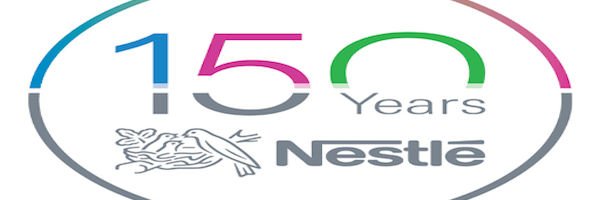
Nestle – Ready for the next 150 Years in (Climate) changing times?
When a company already has a 150-years legacy, and offers products for Nutrition, Health and Wellness across the globe – there’s clearly a lot at stake in these (climate) changing times. Nestle, which makes everything from chocolate and coffee, to baby food, pizza, milk, ice cream, and packaged meals, not only caters to billions of consumers, but also partners with over 165,000 suppliers and 695,000 farmers worldwide. [1]
Nestle has seen climate change impact its business. Climate change is bad for farmers and agriculture – Drought, flooding, and hotter growing conditions threaten the world’s food supply and contribute to food insecurity. Global weather patterns affect crop yields, water availability and infrastructure integrity. [2] Paul Grimwood, Chairman and CEO of Nestle USA clearly acknowledges the huge task at hand to adapt to this. According to him, “Nestlé intends to flourish for at least another 150 years, and we believe tackling climate change is key to a healthy planet and healthy people.”
Even though Nestle has adopted strategies to tackle climate change, it faces constant pressure to match rising consumer demands without increasing emissions that cause climate change. For some of its flagship products that use materials like Cocoa and Coffee – there is a huge question around sustainability of prices as water shortage is fueling the problem further. [3]. Nescafe and Nespresso coffee brands of Nestle contribute to 10% of the world’s coffee, sourced through more than 200,000 farmers. Declining yields, water shortage, greenhouse gases all are threats to Nescafe and the farmer population associated with Coffee. As a result, they have come up with something called ‘The Nescafe Plan’ to create a sustainable foundation. [4]
Due credit needs to be given to Nestle for taking a holistic stock of the situation and devising a foundational roadmap to deal with climate change and related issues spanning its entire value chain.
Some of the goals Nestle has set for itself:
- By 2015: Reduce its direct GHG emissions per tonne of product by 35% versus 2005, resulting in an absolute reduction of GHG emissions.
- By 2016: All new ice cream chest, upright and island freezers will use natural refrigerants.
- By 2016: Expand the use of natural refrigerants, which do not harm the ozone layer and have a negligible impact on climate change, in our industrial refrigeration systems.
- By 2016: 40% of the volume of the 12 priority categories of raw materials will be assessed against their Responsible Sourcing Guideline requirements [5] and should be compliant, or improvement plans to preserve natural capital should be ongoing.
- By 2017: All new refrigerated trucks will use natural refrigerants.
- By 2020: All new proprietary cold beverage dispensers of Nestlé Professional will use natural refrigerants.
How are these initiatives going for Nestle so far?
They surpassed their 2015 objective by reducing direct GHG emissions per tonne of product by 42.7% versus 2005, resulting in an absolute reduction of 14%. Besides, they have invested CHF 289 Million in replacing synthetic refrigerants with natural alternatives in refrigeration systems.
The Nestle Way – Sustainability initiatives across the entire product lifecycle [6]
To create a compass that helps them map and assess their progress, they’ve created the Nestle Policy on Environmental Sustainability , commiting to sustainable business practices across the entire product lifecycle. In simple terms, this means improving resource efficiency, using sustainably managed and renewable resources, and targeting zero waste. A ‘Nestle in Society Board’ which has various task forces to tackle some of the material issues. In 2015, more than 4000 employees acros the world took the ‘Environment sustainability at Nestle e-Learning course’.
To walk the talk and demonstrate leadership in climate change initiatives, they scored 99 out of 100 on the Dow jones Sustainability Index. [7]
Some other notable initiatives specifically around raw materials like coffee:
- Launched the Nespresso agro-forestry programme, helping coffee farmers improve resilience to climate change through agro-forestry.
- Planting trees or shrubs among crops helps to tackle soil erosion and make land use more sustainable.
- Through a partnership with the NGO Pur Projet, we piloted the approach in Guatemala and Colombia, with Nestlé technicians helping to coordinate and evaluate planting activities.
Sounds Perfect – But what pitfalls to avoid?
Even though the systems Nestle has put across its Value chain to mitigate and measure its environmental impact appear reasonable, there are still unresolved questions and possibilities.
The pressure of growth and matching rising consumer demand still leans on raw material availability – how can we manage sustainable practices and generate higher yields? How can they enable and support the farmers and producers of their raw materials over the next decade? [8]
How does Nestle increase budgets to focus on sustainability in the shorter run when margins are being squeezed at the bottom of the supply chain?
[Word count: 792]
[1]:”How climate change is affecting the world’s biggest food company ” The Washington Post. https://www.washingtonpost.com/news/wonk/wp/2014/09/05/how-climate-change-is-affecting-the-worlds-biggest-food-company/
[2]:”Global Food Companies Unite On Climate Action” https://www.ceres.org/press/press-releases/global-food-companies-unite-on-climate-action
[3]:”Coffee Sourcing at Nestle” http://www.nestle.com/csv/rural-development-responsible-sourcing/nescafe-plan
[4]:”Nestle – Creating Shared Value (CSV) Report 2015″ http://storage.nestle.com/nestle-society-full-2015/index.html#116
[5]: “Suppliers at Nestle” http://www.nestle.com/aboutus/suppliers
[6]:”Nestle – Creating Shared Value (CSV) Report 2015″ http://storage.nestle.com/nestle-society-full-2015/index.html#170/z
[7]:”RobecoSam – Sustainability Investing” http://www.sustainability-indices.com
[8]: “We’re all facing risks of having Supply challenges” https://www.euractiv.com/section/agriculture-food/interview/nestle-executive-we-are-all-facing-risks-of-having-supply-challenges/


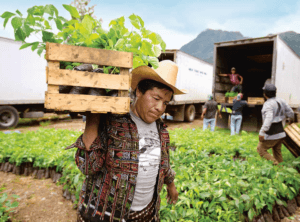
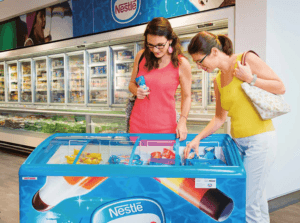



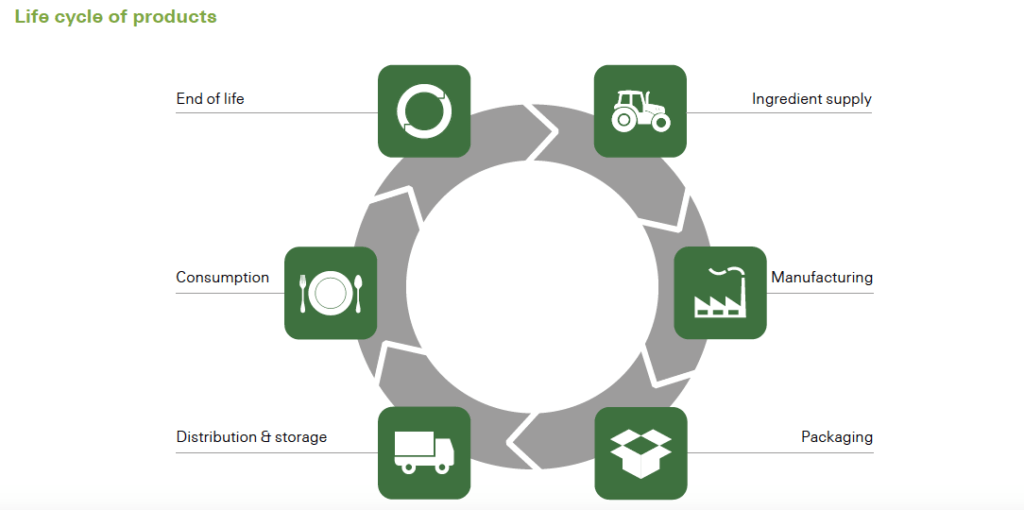
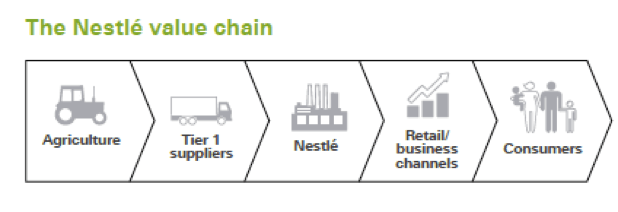
Thanks for the great article! It certainly seems that Nestle is doing a fair bit to implement sustainable practices across their value-chain.
I do however, question Nestle’s motives and the extent of their commitment to ethical and sustainable practices. Last year, Nestle came under fire for not shutting down its water bottling plants in California despite severe drought. It was claimed that they even interfered with local elections to try to get control of water sources in the region! For a long time, they were sourcing palm oil (used in their chocolate products) from suppliers that were destroying Indonesian rain-forests. Only after extensive lobbying and protests from Greenpeace have they finally begun to source palm oil in accordance with Responsible Sourcing Guidelines. Most recently with the ban of Maggi in India, they were accused of not meeting environmental and food regulation standards with illegal quantities of lead in their products! I think that Nestle needs to take a stronger stance on their commitment to the environment and not just focus on the areas that benefit them in the near term.
The Nespresso brand provides an interesting case study into Nestles sustainability efforts and the conflicts of interest inherent in these efforts:
A number of studies have found that single serve coffee pods are less environmentally friendly than traditional drip brewing. [1] The Nespresso pods are constructed using aluminum (which has a carbon intensive supply chain to produce) and cannot be recycled without separating the component parts of the pod. While Nestle has started a recycling program allowing consumers to mail back pods for recycling (in the continental U.S.) with pre-paid postage, it is not heavily advertised, and still requires consumers to deliver the bag to a UPS location. [2]. While this is a step in the right direction, there is clearly a tension between either advertising this program or redesigning capsules to be more easy to recycle at home and Nestle’s bottom line.
[1] “Taking a close look at the eco-balance of coffee capsules” https://www.empa.ch/web/s604/it-all-depends-on-the-coffee, accessed Nov. 2016
[2] https://www.nespresso.com/us/en/order/accessories/vertuo/recycling-bag